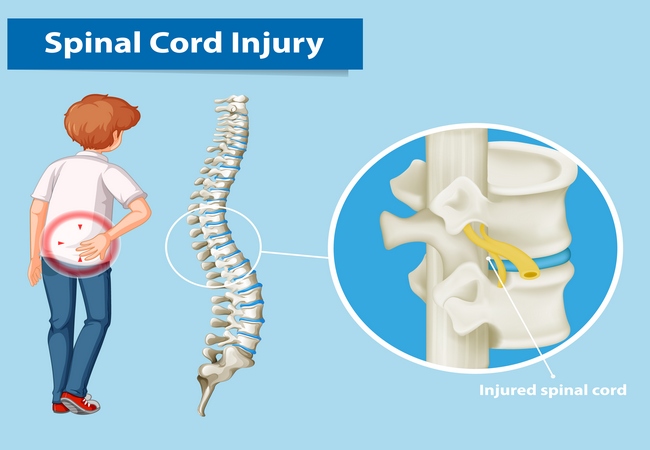Definition of Spinal Cord Injury:
A spinal cord injury is the damage to any part of the spinal cord or nerves at the end of f 1 the spinal canal often causes permanent changes in strength. Sensation and other body functions below the site of the injury.

Causes of Spinal Cord Injury:
1. Motor vehicle accidents:
Auto and motorcycle accidents are the leading cause of spinal cord injuries, accounting for more than 35 percent of new spinal cord injuries each year.
2. Falls:
This type of injury after age 65 is most often caused by a fall. Overall, falls cause more than one-quarter of spinal cord injuries.
3. Acts of violence:
Around 15 percent of spinal cord injuries result from violent encounters, often involving gunshot and knife wounds, according to the National Spinal Cord Injury Statistical Center.
4. Sports and recreation injuries:
Athletic activities, such as impact sports and diving in shallow water, cause about 9 percent of spinal cord injuries.
5. Alcohol:
Alcohol use is a factor in about 1 out of every 4 spinal cord injuries.
6. Diseases:
Cancer, arthritis, osteoporosis and inflammation of the spinal cord also can cause spinal cord injuries.
Sign and Symptoms of Spinal Cord Injury:
Spinal cord injuries of any kind may result in one or more of the following signs and symptoms:
- Loss of movement.
- Loss of sensation, including the ability to feel heat, cold and touch.
- Loss of bowel or bladder control.
- Exaggerated reflex activities or spasms.
- Changes in sexual function, sexual sensitivity and fertility.
- Pain or an intense stinging sensation caused by damage to the nerve fibers in your spinal cord.
- Difficulty breathing, coughing or clearing secretions from your lungs Emergency signs and. Symptoms.
Emergency signs and symptoms:
Emergency signs and symptoms of this type of injury after an accident may include-
- Extreme back pain or pressure in your neck, head or back.
- Weakness, incoordination or paralysis in any part of your body.
- Numbness, tingling or loss of sensation in your hands, fingers, feet or toes.
- Loss of bladder or bowel control.
- Difficulty with balance and walking.
- Impaired breathing after injury.
- An oddly positioned or twisted neck or back.

Maria Khatun Mona is a Founder and Editor of Nursing Exercise Blog. She is a Nursing and Midwifery Expert. Currently she is working as a “Senior Staff Nurse” at “Dinajpur Medical College Hospital”, Bangladesh. She has great passion in writing different articles on Nursing and Midwifery. Mail her at “maria.mona023@gmail.com”
